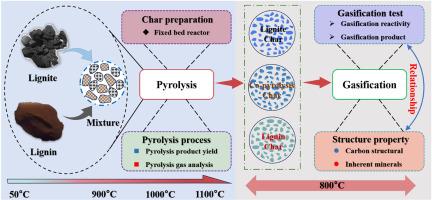Physicochemical properties and carbon dioxide gasification reactivity analysis of lignin and lignite co-pyrolysis char
IF 6.2
2区 工程技术
Q2 ENERGY & FUELS
引用次数: 0
Abstract
Co-gasification of biomass with coal enables more efficient utilization of carbon resources and reduces greenhouse gas emissions. In this study, the isothermal CO2 gasification behavior of lignin/Manglai lignite co-pyrolysis char was investigated at 900–1100 °C using a thermogravimetric analyzer and a fixed-bed reactor. The structural characteristics of co-pyrolysis char were analyzed by N2 adsorption-desorption, scanning electron microscopy, Raman spectroscopy, X-ray diffraction, Fourier transform infrared spectroscopy, and X-ray fluorescence spectroscopy. The results show that the degree of graphitization of co-pyrolysis char is higher than that of lignin and lignite char. Additionally, the morphology of the internal minerals in the char changes during the gasification process, resulting in a significant reduction in gasification reactivity. The gasification reactivity of lignin/Manglai lignite (LLC) co-pyrolysis char is lower than that of single lignin char, and its maximum CO formation rate and gas accumulation are the lowest at 1100 °C pyrolysis temperature. These findings highlight the influence of pyrolysis temperature on char structure and gasification performance, and provide valuable insights for optimizing the co-gasification process and improving CO2 utilization efficiency. This study provides new insights into the gasification behavior of lignin–lignite mixtures and offers practical implications for sustainable energy utilization.

木质素与褐煤共热解炭的理化性质及二氧化碳气化反应性分析
生物质与煤共气化可以更有效地利用碳资源,减少温室气体排放。本研究采用热重分析仪和固定床反应器,研究了木质素/芒莱褐煤共热解焦在900 ~ 1100℃的等温CO2气化行为。采用N2吸附-解吸、扫描电镜、拉曼光谱、x射线衍射、傅里叶变换红外光谱和x射线荧光光谱分析共热解炭的结构特征。结果表明,共热解炭的石墨化程度高于木质素和褐煤炭。此外,在气化过程中,炭中内部矿物的形态发生变化,导致气化反应性显著降低。木质素/芒莱褐煤(LLC)共热解炭的气化反应活性低于单一木质素炭,在1100℃热解温度下,其最大CO生成速率和气体富集量最低。这些发现突出了热解温度对炭结构和气化性能的影响,为优化共气化工艺和提高CO2利用效率提供了有价值的见解。该研究为木质素-褐煤混合物的气化行为提供了新的见解,并为可持续能源利用提供了实际意义。
本文章由计算机程序翻译,如有差异,请以英文原文为准。
求助全文
约1分钟内获得全文
求助全文
来源期刊

Journal of The Energy Institute
工程技术-能源与燃料
CiteScore
10.60
自引率
5.30%
发文量
166
审稿时长
16 days
期刊介绍:
The Journal of the Energy Institute provides peer reviewed coverage of original high quality research on energy, engineering and technology.The coverage is broad and the main areas of interest include:
Combustion engineering and associated technologies; process heating; power generation; engines and propulsion; emissions and environmental pollution control; clean coal technologies; carbon abatement technologies
Emissions and environmental pollution control; safety and hazards;
Clean coal technologies; carbon abatement technologies, including carbon capture and storage, CCS;
Petroleum engineering and fuel quality, including storage and transport
Alternative energy sources; biomass utilisation and biomass conversion technologies; energy from waste, incineration and recycling
Energy conversion, energy recovery and energy efficiency; space heating, fuel cells, heat pumps and cooling systems
Energy storage
The journal''s coverage reflects changes in energy technology that result from the transition to more efficient energy production and end use together with reduced carbon emission.
 求助内容:
求助内容: 应助结果提醒方式:
应助结果提醒方式:


